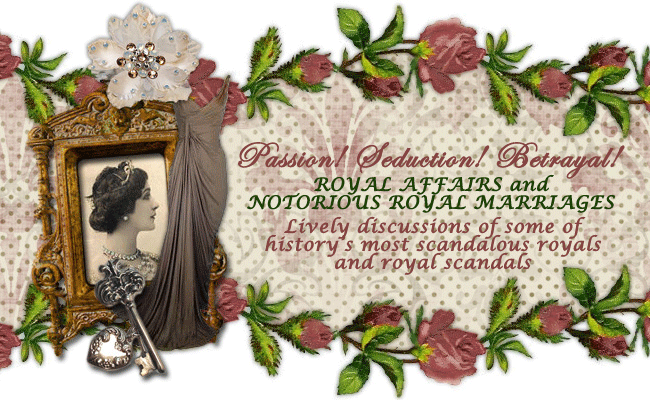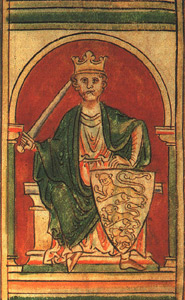
Nell Gwyn (or is it Barbara Palmer, Lady Castlemaine?) with one of her her royal bastards by Charles II
My first book as a newlywed is all about adultery. I should qualify that by explaining that my first work of nonfiction (as a newlywed) is all about adultery.
Actually, as a novelist, by the time that ROYAL AFFAIRS: A Lusty Romp Through the Extramarital Adventures that Rocked the British Monarchy hits the bookshelves on June 3, 2008, I will have seven works of contemporary fiction published under my name and four published works of historical fiction under my pen name for that genre, Amanda Elyot.
I spent the spring, summer, and autumn of 2007 as a fly on the wall in the glittering, debauched court of King Charles II, cavorting with Windsor and Wallis, and with Charles and Camilla, with The Fair Rosamund, and with The Jersey Lillie. For most of August, I climbed into bed with the Tudors .
NAL, my (Amanda's actually) historical fiction publishers have afforded me the opportunity to flex my authorly muscles, with my first non-fiction contract.
Writing ROYAL AFFAIRS has been, and continues to be, as I deliver the revisions, a daunting task, made no less scary by a tight deadline, a mandated page count, and the vast amount of research necessary to do the job.
Nearly every morning since the middle of May, I shuffled from my bedroom to my home office and glanced (and sometimes glared) at the piles of books on and around my desk and wonder how the heck I’m going to do this job to my own demanding standards.
My initial thoughts as I sat down to structure the volume were: given the parameters of the contract, how do I deliver 50-plus entries with (doing the math) a proscribed page count for each entry, when there’s often so much juicy information about these royals and their paramours? How do I decide what to keep and what to (very reluctantly) omit because of time and space issues? How do I deliver a delicious-but-nutritious bit of amorous history, full of flavor and spice, in an appetizer-sized portion? And most importantly—how do I get it right? And what if there’s just no “there” there?
My publisher asked for a table of contents before I began my research in earnest, so I pulled together a list of more than fifty affairs. I reminded them that the list was just a draft because my research might uncover some juicy liaisons I hadn’t previously known about (and therefore weren’t listed in that table of contents). Conversely, I cautioned that I might have to scrap some of the relationships if I just couldn’t find any legitimate sources to confirm them.
Richard I
The love life of Richard I, also known as Richard the Lionhearted, was one such case in point. He may, or may not, have had a passionate relationship with King Philip II of France. I added Richard to the table of contents based on scenes from the film The Lion in Winter, and from historical tidbits I have read for years about Richard’s homosexuality. This is not what is considered legitimate research!
I'll be blogging about the Hollywood versions of some of these libidinous royals as time goes on. Suffice it to say that their celluloid counterparts tend to be anywhere from mildly inaccurate to wildly inaccurate!
So far, I have not found a single credible source (though I keep looking) to substantiate the supposition, other than a lone paragraph written by a medieval historian, which can be parsed to suggest that Richard and Phillip were lovers, but is more easily explained by many other historians as exemplary of the customs of the day between two monarchs demonstrating their détente. And the rest of their story—political adversaries during the bloody and brutal Third Crusade—does nothing to suggest that the two of them shared a romantic backstory. Yet, history is colored by the times; no one in 1199 was about to eulogize their late king as a great gay warrior. Yet a historian looking back from 1999 might have an agenda they want to promote, and consequently will look for, and manipulate, what little facts exist in order to support the tale they wish to tell.
Well, obviously, a non-fiction book cannot be written based on scenes from a movie, or chapters of historical fiction. So, after giving myself a good amount of time to look for it, I found no solid academic justification for an affair, and jettisoned the entry from the Table of Contents.
In historical fiction we have the privilege and the joy of making things up, of filling in the gaps in a person’s life story with colorful scenes of “what if?” We are novelists, not historians, who bring our own prejudices to the narrative and put our own spin on it. In fiction, when we choose to illuminate the lives of characters whom history has judged more harshly than we do, we give them vulnerable warm and fuzzies, so that readers will feel for them. You don’t get to do that in non-fiction.
What I’m getting to is, I can’t make stuff up. Obviously. And yet that’s one problem I have encountered in the numerous research books and biographies I have been poring over, and will continue to plough through: how do I know they’ve got it right? We all know that internet research is dodgy. In this most democratic arena, anyone can post something, regardless of their credentials, and very often the information is not entirely bona fide. If a date is wrong, is it because of bad research, or is it a typo that no one bothered to catch? Online, there’s an abundance of blatantly incorrect information slyly masquerading as truth.
As I did my research, I was never confident of what was accurate unless I checked several sources. Given my short deadline for ROYAL AFFAIRS, I resorted to internet research, but only as a backup for vetted and published works of non-fiction.
Yet, who vetted the books I was poring over? Academics, journalists, novelists—suddenly all of these people are considered historians because they have a non-fiction work on the bookshelves. How good is their research? Editors and copyeditors are supposed to make the manuscript read well; it’s not in their job description to make sure the author got it right. Chances are, no one reviewed the manuscript as a fact-checker, unless the book is a published version of someone’s PhD thesis, where the candidate was severely grilled by a committee. And how am I to know that the research done by these so-called scholars is impeccable? How do I prevent myself from regurgitating “bad history” in my own book?
Among the pile of books on my desk was a book about European royal scandals. This one is now collecting dust because I’m afraid of using it any more, wondering what else the author got wrong. Here’s why: as soon as I got the volume, I turned to the alphabetical index at the back of the book and looked for the name of someone I “knew.”

In the course of my research for my next historical novel, ALL FOR LOVE (to be published by NAL on Feb. 5, 2008), I spent more than two years with the 18th-century actress and royal mistress (and oh-so much more than that) Mary Robinson. I’ve read at least a half dozen biographies of her, including her own memoirs. The author of the non-fiction book I refer to in this paragraph gave Mary Robinson a child by the Prince of Wales!
Well! That just didn’t happen! And it’s not even a tiny gaffe on the part of the writer—it’s an egregious error of fact. So, because I’m not an expert on the lives of the other people discussed in that book, how do I know that anything else in it is valid research bolstered by solid facts? I don’t, unless I review several other sources and get a concurrence. I just have to do the best I can, and promise my readers that I am doing my due diligence—all within the time frame I have been given to write the book.
My goal is to make it juicy and racy, informative and entertaining--and as right as I can get it.









.jpg)

